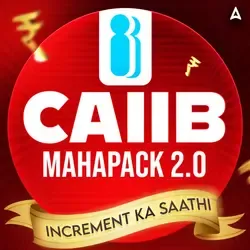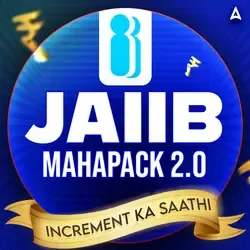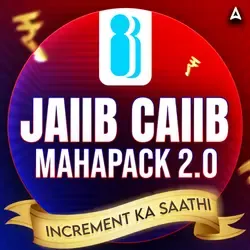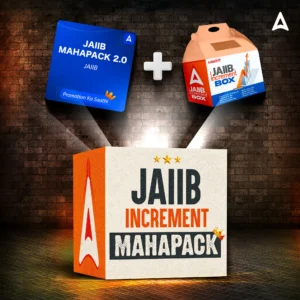Table of Contents
Indian Financial System(Module A) Notes: There are 3 papers in the JAIIB Exam 2022, Principles & Practices of Banking(Paper 1), Accounting & Finance for Bankers(Paper 2), and Legal & Regulatory Aspects of Banking(Paper 3). The candidates preparing for the upcoming JAIIB Exam 2022 must be updated with each and every module of JAIIB. Along with their preparation, aspirants should make short notes of the module they cover. Here we have provided an overview of the Indian Financial System(IFS). IFS is the first module(Module A) of PPB. Indian Financial System(Module A) Notes will surely be beneficial to the candidates and help them score better in the upcoming exam. The overall summary of all the units of Module A is summed up which will assist the aspirants during their revision time.
IFS Notes Unit 1: Indian Financial System- An Overview
- The three regulatory authorities are:
RBI( Reserve Bank of India) – for banks,
SEBI (Securities and Exchange Board of India) – for capital markets and
IRDA (Insurance Regulatory and Development Authority of India) – for insurance sectors. - NBFC (Non Banking Financial Company) are allowed to upraise money from the public and lend monies through various instruments for ex leasing, hire purchase and bill discounting.
- Co-operative banks are allowed to uplift deposits and give advances from or to public.
- Urban co-operative banks are controlled by the State government and the Reserve Bank of India( RBI).
- Co-operative banks other than urban co-operative banks are controlled by the State Government and NABARD.
- Financial Institutions(FI) are institutions which provide long term funds for industry and agriculture.
- Primary dealers deal in government securities, primary and also with secondary markets.
- SEBI ( Securities and Exchange Board of India) is the capital market regulator.
- Merchant bankers are licensed by SEBI and they issue stocks, raise fund and manage them.
- FII(Foreign Institutional Investors) are given permission by SEBI to invest in Indian equity and debt market through stock exchanges.
- CRR(Cash Reserve Ratio)is the percentage of a bank’s total deposits that it needs to maintain as liquid cash.
- SLR(Statutory Liquidity Ratio) is the minimum percentage of demand and time liabilities of a bank which is held in prescribed government securities by the bank.
- Bonds and debentures are examples of corporate securities and can be used to elevate debts.
- Debts, equities and derivatives are examples of securities.
- Depositories hold securities in demat form (not physical).
- Mutual fund pools money from investors and invests in stocks, debt and other securities.
IFS Notes Unit 2: Banking Regulation
- RBI was formed under the RBI Act 1934.
- RBI started its operations from 1 Apr 1935.
- RBI is a state owned institution under the RBI (Transfer of Public Ownership) Act 1948.
- RBI has 4 Deputy Governors and 15 Directors recommended by the Union government.
- Re 1 Note and all types of coins are issued by Government of India but put into circulation by RBI.
- RBI manages the exchange rate between the Indian Rupee and foreign currencies by selling and buying foreign exchange to and from Authorized Dealers (RBI’s specified branches and other dealers).
- Saving and current accounts are demand liabilities.
- Reducing CRR reduces loanable funds with banks.
- RBI can prescribe SLR from 0 to 40 percent of bank’s DTL( Diploma in Taxation Laws).
- Increasing SLR reduces loanable funds with banks.
- Bank rate is the rate at which RBI is prepared to buy or rediscount bills of exchange or other eligible commercial paper from banks.
- Important macroeconomic policies:
Monetary and credit policies – issued by RBI annually
Fiscal policy – issued by Ministry of Finance
EXIM policy – Ministry of Commerce - Open market operations means to sale or purchase of government securities by RBI in the open market.
- Selective credit control(SCC) is another tool that RBI uses for monetary control. It prevents holding of essential commodities and resultant increase in their prices. Presently buffer stocks of sugar, unreleased stocks of sugar with sugar mills representing free sale sugar and levy sugar are covered by SCC.
- No bank held shares in a company as pledge or mortgagee in excess of the limit of 30% of the paid-up capital of that company or 30% of the bank’s Paid-up capital and reserves, whichever is less.
IFS Notes Unit 3: Retail Banking
- Retail banking allude to dealing of commercial banks with individual customers, both assets and liabilities sides. Products offered are: SB, RD, CA, TDR, STDR, No Frill A/C, Home loan, auto loan, personal
loan, education loan, crop loan, credit card, debit cards, lockers, bank assurance etc. - Wholesale banking or corporate banking or commercial banking refers to doing banking business with industrial and business entities – mostly corporate and trading houses, including multinationals, domestic business houses and prime public sector companies. Products offered are: LC, BG, Collection of bills and documents, forex desk, tax collection, RTGS, term lending, etc.
- Universal banking, customers are offered all types of financial products like mutual fund, capital market related products including share broking, commodity broking, etc., sale of gold or bullion, government or corporate bonds, merchant banking, general banking, insurance (both life and non-life), etc. under one roof.
- In International banking dealing in cross border transaction is done.
- A Depository Receipt (DR) is a form of negotiable (transferable) financial instrument that is traded on a local stock exchange of a country but represents a security, usually in the form of equity that is issued by a foreign publicly listed company.
- Participatory Notes are like contract notes which are issued by FII to entities that wish to invest in the Indian stock market but do not want to register themselves with the SEBI.
- FII are not allowed to issue Participatory notes to Indian national or overseas corporate bodies (because majority are owned or controlled by NRIs).
IFS Notes Unit 4: Role of Money Markets, Fixed Income Markets, Forex Markets and FEMA
- “Money Market” allude to the market for short-term requirement and deployment of funds. Money market instruments are those instruments, which have a maturity period of less than one year. The most active part of the money market is the market for overnight call and term money between banks and institutions and repo transactions. Call Money or Repo are very short-term Money Market products. The below mentioned instruments are normally termed as money market instruments:
- Certificate of Deposit (CD)
- Commercial Paper (C.P)
- Inter Bank Participation Certificates
- Inter Bank term Money
- Treasury Bills
- Bill Rediscounting
- Call or Notice or Term Money
- Money markets play a key role in banks’ liquidity management and the transmission of monetary policy.
- In normal times, money markets are among the most liquid in the financial sector.
- By providing the appropriate instruments and partners for liquidity trading, the money market allows the refinancing of short and medium-term positions and facilitates the mitigation of your business’ liquidity risk.
- The banking system and the money market represent the exclusive setting monetary policy operates in.
- A developed, active and efficient interbank market enhances the efficiency of central bank’s monetary policy, transmitting its impulses into the best economy.
- Development of the money market flushes the progress of financial intermediation and boosts lending to economy, hence improving the country’s economic and social welfare.
- Therefore, the development of the money market is in all stakeholders’ interests: the banking system itself, the Central Bank and the economy on the whole.
- Government Securities are issued by the Government for raising a Public loan or as notified in the official Gazette.
- Government Securities consist of Government Promissory Notes, Bearer Bonds, Stocks or Bond held in Bond Ledger Account. They may be in the form of Treasury Bills or Dated Government Securities.
- Government Securities are mostly interest bearing dated securities issued by RBI on behalf of the Government of India.
- Features of Government Securities:
- Issued at face value.
- No default risk as the securities carry sovereign guarantee.
- Ample liquidity as the investor can sell the security in the secondary market.
- Interest payment on a half yearly basis on face value.
- No tax deducted at source.
- Can be held in Demat form.
- Government of India uses these funds to meet its expenditure commitments. These securities are generally fixed maturity and fixed coupon securities carrying semi-annual coupon. Since the date of maturity is specified in the securities, these are known as dated Government Securities.
- Corporate bonds are debt securities provided by private and public corporations.
- Companies issue corporate bonds to raise money for a variety of purposes, such as building a new plant, purchasing equipment, or growing the business. When one buys a corporate bond, one lends money to the “issuer,” the company that issued the bond.
- In exchange, the company promises to return the money, also known as “principal,” on a specified maturity date. Until that date, the company usually pays you a stated rate of interest, generally semiannually.
- While a corporate bond gives an IOU from the company, it does not have an ownership interest in the issuing company, unlike when one purchases the company’s equity stock.
- An interest rate swap (IRS) is a liquid financial derivative instrument in which two parties agree to exchange interest rate cash flows, based on a specified notional amount from a fixed rate to a floating rate (or vice versa) or from one floating rate to another.
- An interest rate future is a financial derivative (a futures contract) with an interest-bearing instrument as the underlying asset. It is a particular type of interest rate derivative.
- LIBOR or ICE LIBOR (previously BBA LIBOR) is a benchmark rate that some of the world’s leading banks charge each other for short-term loans.
- It stands for Intercontinental Exchange London Interbank Offered Rate and serves as the first step to calculating interest rates on various loans throughout the world.
- LIBOR is administered by the ICE Benchmark Administration (IBA), and is based on five currencies: U.S. dollar (USD), Euro (EUR), pound sterling (GBP), Japanese yen (JPY) and Swiss franc (CHF).
- It serves seven different maturities: overnight, one week, and 1, 2, 3, 6 and 12 months. There are a total of 35 different LIBOR rates each business day. The most commonly quoted rate is the three-month U.S. dollar rate.
- The Mumbai Interbank Offered Rate (MIBOR) is calculated everyday by the National Stock Exchange of India (NSEIL) as a weighted average of lending rates of a group of banks, on funds lent to first-class borrowers.
- MIBOR is the interest rate at which banks can borrow funds, in marketable size, from other banks in the Indian interbank market.
- The MIBOR was launched on June 15, 1998 by the Committee for the Development of the Debt Market, as an overnight rate.
- The NSEIL launched the 14-day MIBOR on November 10, 1998, and the one month and three month MIBORs on December 1, 1998.
- Since the launch, MIBOR rates have been used as benchmark rates for the majority of money market deals made in India.
- Foreign Exchange Management Act (FEMA), 1999 is applicable-
-
- To the whole of India.
- Any Branch, office and agency, which is situated outside India, but is owned or controlled by a person resident in India
IFS Notes Unit 5: Role of Capital Markets, Securities and SEBI
- Capital market is a market for long term debt and equity shares (both are issued and traded).
- Two types of capital market are: primary and secondary.
- Primary Market – In the primary market, securities (shares, bonds, debentures) are offered to the public for subscription, for raising capital or fund.
- Secondary Market – In the secondary market, securities are traded after being initially offered to the public in the primary market and/or listed on the Stock Exchange. Secondary market comprises equity markets and debt markets.
- Corporatization is the process of converting the organizational structure of the Stock Exchange from a non-corporate to a corporate structure.
- Demutualization refers to the transition process of a Stock Exchange from a mutually owned association to a shareholders-owned company.
- FII can invest up to 49 % in Stock Exchange in India.
- No single investor can hold shares in an Indian Stock Exchange beyond a limit of 5%.
- A broker is registered with SEBI and is a member of a recognized Stock Exchange and is permitted to do trading of different Stock Exchanges.
- Government securities are coupon bearing instruments which are issued by RBI on behalf of Government of India. Government securities have maturity dates ranging from less than 1 year to a max of 30 year.
- Debentures are bonds issued by a company. It has fixed rate of interest usually payable half-yearly, on specific dates and the principal amount repayable on a particular date on redemption of debenture. It is an unsecured debt.
- A bond is a negotiable certificate usually unsecured. In coupon bonds, interest are paid bi-annually, in zero-coupon bonds, interest is paid at the maturity.
- Commercial papers are borrowing of a company from the market. These money market instruments are issued for 90 days.
- Treasury bills are securities issued by RBI on behalf of Government of India for 91 days.
- IPO refers to issue of fresh securities by an unlisted company or an offer for sale of its existing securities or both for the first time to the public.
- FPO refers to issue of fresh securities by an already listed company or an offer for sale to the public through an offer document.
- Rights Issue is when a listed company issues fresh securities to its existing shareholders as on a recorded date.
- A private placement is an issue of shares or of convertible security by a company to a select group of persons under section 81 of the Companies Act 1956.
- Any company making a public issue or a listed company making a RI of a value of more than Rs 50 lacs is required to file a draft offer document with SEBI for its observations. This observation period is only 3 months.
- DIP stands for Disclosure and Investor Protection guidelines.
- Offer document means prospectus in case of public issue.
- Offer document means an offer for sale and letter of offer in case of a RI.
- Offer documents are filed with Registrar of Companies and Stock Exchanges.
- A draft offer document means the offer document in a draft stage.
- The draft offer documents are filed with SEBI.
- The period of filing draft offer document is at least 21 days prior to that of offer document.
- RHP (Red Herring Prospectus) is a prospectus which doesn’t have details of either price of number of shares being offered or the amount of issue. But the number of shares and the upper and lower price bands are disclosed.
- In case of FPO, the RHP can be filed with Registrar of Companies without the price band. The price band is notified one day prior to the opening of the issue by way of an advertisement.
- In book-built issue, price cannot be determined until the bidding process is completed.
- In a book-built issue allocation, RII: NII: QIP::35: 15: 50 (or may be 60:10:30). RII – Retail Individual Investors. NII – Non-Institutional Investors. QIP – Qualified Institutional Placement.
- Retail individual investor means an investor who applies or bids for securities of or for a value not more than Rs 1,00,000.
- A merchant banker possessing a valid SEBI registration in accordance with the SEBI (Merchant Bankers) Regulations, 1992 is eligible to act as a BRLM (Book running Lead Manager).
- A QIB (Qualified Institutional Buyer) means those investors who have expertise and financial muscle to evaluate and invest in capital market. Examples: mutual fund, scheduled commercial banks, FII registered with SEBI, insurance companies registered with IRDA, PF with a minimum corpus of Rs 25 crore etc.
- Above mentioned entities are not required to be register with SEBI as QIB.
IFS Notes Unit 6: Mutual Fund and IRDA
1. Mutual fund is a mechanism for pooling resources from the public by issuing units to them and investing the funds in securities.
2. Mutual fund set up in the form of a trust and is registered with SEBI.
3. Unit holders refer to investor in mutual fund.
4. NAV denotes performance of a particular scheme of a mutual fund.
5. NAV per unit is the market value of securities of a scheme, less the expenses incurred on the scheme divided by the total number of units of the scheme on any particular date.
6. The scheme that is available for subscription and repurchase on a continuous basis is known as open ended scheme/plan.
7. The scheme that is available for subscription only during a specified period at the time of launch of the scheme is a close ended scheme. It has a maturity period 3-10 years.
8. Growth scheme aka equity oriented scheme invest in equities (higher risks).
9. Income scheme/debt oriented scheme invest in fixed income securities such as bonds, government securities, corporate debentures and money market instruments.
10. Balanced plan invest both in equities and fixed income securities (debt instruments) in 40-60%.
11. Money market or liquid fund invest in (safer short-term instruments) treasury bills, certificates of deposit, commercial paper and interbank call money, government securities, etc.
12. Gilt fund invest in government securities.
13. Repurchase or redemption price is the price or NAV at which an open-ended scheme purchases or redeems its units from the unit holders.
IFS Notes Unit 7: Factoring and forfaiting
1. Factoring is a service that is connected with the financing and collection of account receivables in domestic and international trade.
2. Forfaiting is a means of finance (credit) an exporter of goods avails from an intermediary called the forfeiture against the export receivables but without the obligation to repay the credit. It is used in international trade.
3. The items in the books of a bank which are not mentioned in the balance sheet, is known as off-balance sheet items. These are not assets or liabilities but may get converted into assets/liabilities upon happening of certain events. That’s why off balance sheet items are aka contingent liabilities.
4. Bank Guarantee is a contract of Guarantee means a contract to perform the promise or discharge the liability of a third person in case of his default.
5. There are 3 persons in case of a Bank Guarantee – the guarantor/surety, Principal debtor, and the creditor/beneficiary.
6. Bank Guarantee is a contingent liability.
7. A Letter of Credit is an undertaking given by the buyer’s bank on behalf of the buyer to the seller, stipulating that if specified documents are presented within a stipulated date, the bank establishing the credit will pay the amount of the bill drawn in terms of such Letter of Credit.
8. There are 4 persons in case of a Letter of Credit – buyer, opening bank/branch, seller, and negotiating bank/branch.
9. A forward exchange contract is a firm contract between the bank and its customers for the purchase/sale of a specified quantity of a stated foreign currency at a predetermined rate. On the due date when the contract is executed, the transaction will be at the contracted rate of exchange instead of the rate then prevailing, thus it is method of protecting oneself against exchange rate fluctuations.
10. FRA (Forward Rate Agreement) and IRS (Interest Rate Swap) are such instruments that can provide effective hedge against interest rate risks.
11. An FRA is a financial contract between 2 parties to exchange interest payments for a notional principal amount on the settlement date for a specified period from start date to maturity date.
12. An IRS is a financial contract between two parties exchanging or swapping a stream of interest payments for a notional principal amount on multiple occasions during a specified period. Such contracts involve exchange of fixed to floating or floating to floating rate of interest.
IFS Notes Unit 8: Risk Management and Basel 2 & 3
1. Credit risk is the possibility of losses associated with the reduction in the credit quality of borrowers or counterparties.
Credit risk forms – direct lending, Bank Guarantee, Letter of Credit, treasury operations, securities trading businesses, cross border exposure, etc.
2. Market risk arises from adverse changes in market variables.
Market risk forms – liquidity risk, interest rate risk, foreign exchange rate (forex) risk, commodity price risk, equity price risk, etc.
3. Operational risk (aka legal risk, administrative risk, settlement or payment risk) arises from human or technical errors.
4. Under the Basel I accord, only the credit risk element was considered and the minimum capital requirement of capital funds was fixed at 8 % of the total risk weighted assets.
5. In India, banks are required to maintain a minimum capital to risk weighted asset ratio (CRAR) of 9 %.
6. Basel II has 3 pillars –
- Pillar 1 – minimum capital requirements
- Pillar 2 – supervisory review process
- Pillar 3 – market discipline.
7. The capital base of the bank consists of the following 3 types of capital requirements: Tier 1, Tier 2 and Tier 3.
8. The total of Tier 2 (supplementary) elements will be limited to a maximum of 100 % of the total of Tier 1 capital.
9. Subordinated term debt will be limited to a maximum of 50 % of Tier 1 capital.
10. Tier 3 capital will be limited to 250 % of a bank’s Tier 1 capital that is required to support market risk.
11. Shareholder’s equity and retained earning consists of Tier 1 capital while supplementary refers to Tier 2 capital.
12. The sum of total of Tier 2 and Tier 3 capital should not exceed the total of Tier 1 capital.
IFS Notes Unit 9: Alliances/ Mergers/ Consolidation
Alliance is a mutually agree to commercial collaboration between two to more organizations where they agree to co-operate in the operation of a business activity. They remain independent entities however.
2. Merger/amalgamation means combination of two or more companies into a single company, where one company survives with its name or a combined new name, and other loses its existence.
3. Consolidation is the combination of two existing companies into a new company where old companies lose their existence and a new one is created either with a different name or same name.
4. Acquisition or takeover of a company refers to the acquiring of a controlling stake in the ownership of a company by another entity. This is done by buying the share capital of another company.
IFS Notes Unit 10: Credit Information Companies, Fair Practices Code for Debt Collection, BCSBI
1. CIBIL is a composite credit bureau which contains the credit history of both commercial and consumer borrowers.
2. CIBIL provides credit history of borrowers to its members in the form of credit information reports (CIRs) to assist them in their loan appraisal process.
3. In the matter of recovery of dues, banks / NBFCs may ensure that they, as also their agents, adhere to the extant instructions on Fair Practice Code for lenders as also IBA’s Code for Collection of dues and repossession of security. In case banks / NBFCs have their own code for collection of dues it should, at the minimum, incorporate all the terms of IBA’s Code.
4. In particular, in regard to appointment of third party agencies for debt collection, it is essential that such agents refrain from action that could damage the integrity and reputation of the bank / NBFC and that they observe strict customer confidentiality.
5. All letters issued by recovery agents must contain the name and address of a responsible senior officer of the card issuing bank whom the customer can contact at his location.
6. Banks / NBFCs / their agents should not resort to intimidation or harassment of any kind, either verbal or physical, against any person in their debt collection efforts, including acts intended to humiliate publicly or intrude the privacy of the credit card holders’ family members, referees and friends, making threatening and anonymous calls or making false and misleading representations.
7. The Banking Codes and Standards Board of India (BCSBI) was set up on 18th February 2006 as a collaborative effort of RBI and Banks, on the lines of a similar set up in UK to oversee the “Banking Code”, a voluntary Code, evolved by the British Bankers Association (BBA), which is adopted by all banks in UK.
8. The proposal for setting up the BCSBI was based on the recommendation made by the Committee on Procedures and Performance Audit on Public Services (Tarapore Committee).
9. It provides valuable protection for customers on a day-to-day basis as also in the times of financial difficulty.
10. The code applies to savings deposits and current accounts, card products and services, loans and overdrafts and payment services including foreign exchange.
11. Member banks of BCSBI would put in place the following grievance redressal mechanism in their banks:
- Have a Help desk / Helpline at the branch
- Have a Code Compliance Officer at each Controlling office above the level of the branch
- Display at each branch name and contact number of Code Compliance Officer
- Display Name and address of the Banking Ombudsman.
IFS Notes Unit 11: Recent Developments in the Indian Financial System
1. Indian Government appointed a committee under the chairmanship of Sukhamoy Chakravarty in 1984 to review the Indian monetary system. Later, Narayanan Vaghul working group and Narasimhan Committee was also set up. As per the recommendations of these study groups and with the financial sector reforms initiated in the early 1990s, the government has adopted following major reforms in the Indian money market.
- Deregulation of the Interest Rate
- Money Market Mutual Fund (MMMFs)
- Liquidity Adjustment Facility (LAF)
- Electronic Transactions
- Establishment of the CCIL
- Development of New Market Instruments : The government has consistently tried to introduce new short-term investment instruments. Examples: Treasury Bills of various duration, Commercial papers, Certificates of Deposits, MMMFs, etc. have been introduced in the Indian Money Market.
2. Commercial paper is an unsecured money market instrument issued in the form of a promissory note. It enables highly rated corporate borrowers to diversify their sources of short-term borrowings and to provide an additional instrument to investors.
3. A certificate of deposit is a negotiable money market instrument which is issued in dematerialised form or as a Usance Promissory Note, for funds deposited at a bank or other eligible financial institution for a specified time period.
4. The minimum maturity period of CD is 8 days with effect from 29 Apr 2005.
5. The Reserve Bank has taken many initiatives towards introducing and upgrading safe and efficient modes of payment systems in the country to meet the requirements of the public at large.
6. Since paper based payments occupy an important place in the country, Reserve Bank had introduced Magnetic Ink Character Recognition (MICR) technology for speeding up and bringing in efficiency in processing of cheques.
7. Later, a separate High Value Clearing was introduced for clearing cheques of value Rupees one lakh and above. This clearing was available at select large centres in the country (since discontinued).
8. Recent developments in paper-based instruments include launch of Speed Clearing (for local clearance of outstation cheques drawn on core-banking enabled branches of banks), introduction of cheque truncation system (to restrict physical movement of cheques and enable use of images for payment processing), framing CTS-2010 Standards (for enhancing the security features on cheque forms) and the like.
Electronic Payments
9. The continued increase in the volume of cheques added pressure on the existing set-up, thus necessitating following cost-effective alternative systems.
- Electronic Clearing Service (ECS) Credit
- Regional ECS (RECS)
- Electronic Clearing Service (ECS) Debit
- National Electronic Funds Transfer (NEFT) System
- Real Time Gross Settlement (RTGS)System
- Clearing Corporation of India Limited (CCIL)
Other Payment Systems
10. Pre-paid instruments are payment instruments that facilitate purchase of goods and services against the value stored on these instruments. The value stored on such instruments represents the value paid for by the holders by cash, by debit to a bank account, or by credit card. The pre-paid payment instruments can be issued in the form of smart cards, magnetic stripe cards, internet accounts, internet wallets, mobile accounts, mobile wallets, paper vouchers, etc.
11. The use of pre-paid payment instruments for cross border transactions has not been permitted, except for the payment instruments approved under Foreign Exchange Management Act,1999 (FEMA).
12. Reserve Bank brought out a set of operating guidelines on mobile banking for banks in October 2008, according to which only banks which are licensed and supervised in India and have a physical presence in India are permitted to offer mobile banking after obtaining necessary permission from Reserve Bank
ATMs / Point of Sale (POS) Terminals / Online Transactions
13. As on Feb, 2014, there are over 1,50,008 ATMs (76836 onsite and 73172 offsite) in India. Savings Bank customers can withdraw cash from any bank terminal up to 5 times in a month without being charged for the same (refer RBI circulars for latest changes).
14. Reserve Bank has mandated re-crediting of failed transactions within 7 working day and mandated compensation for delays beyond the stipulated period.
15. As on Feb, 2014, there are over 10 lakh POS terminals in the country, which enable customers to make payments for purchases of goods and services by means of credit/debit cards.
16. To facilitate customer convenience the Bank has also permitted cash withdrawal using debit cards issued by the banks at PoS terminals.
17. Further, to reduce the risks arising out of the use of credit/debit cards over internet/IVR (technically referred to as card not present (CNP) transactions), Reserve Bank mandated that all CNP transactions should be additionally authenticated based on information not available on the card and an online alert should be sent to the cardholders for such transactions.
National Payments Corporation of India
18. The Reserve Bank encouraged the setting up of National Payments Corporation of India (NPCI) to act as an umbrella organisation for operating various Retail Payment Systems (RPS) in India. NPCI became functional in early 2009. NPCI has taken over National Financial Switch (NFS) from Institute for Development and Research in Banking Technology (IDRBT).
19. Oversight of the payment and settlement systems is a central bank function whereby the objectives of safety and efficiency are promoted by monitoring existing and planned systems, assessing them against these objectives and, where necessary, inducing change. By overseeing payment and settlement systems, central banks help to maintain systemic stability and reduce systemic risk, and to maintain public confidence in payment and settlement systems.
Related Posts:
FAQs: Indian Financial System Notes
Q.1 Where can we get the short notes of Module A( Indian Financial System) for JAIIB PPB Exam 2022?
Ans. The short notes of Module A (Indian Financial System) for JAIIB PPB Exam 2022 is given above.
Q.2 How many units are there in the Indian Financial System( Module A) for JAIIB PPB Exam 2022?
Ans. There are 11 units in the Indian Financial System( Module A).

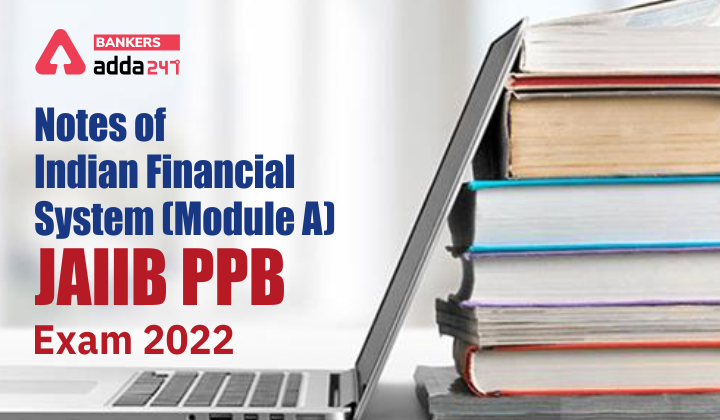




 GA Capsule for SBI Clerk Mains 2025, Dow...
GA Capsule for SBI Clerk Mains 2025, Dow...
 The Hindu Review October 2022: Download ...
The Hindu Review October 2022: Download ...
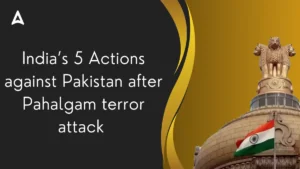 India’s 5 Actions against Pakistan after...
India’s 5 Actions against Pakistan after...

